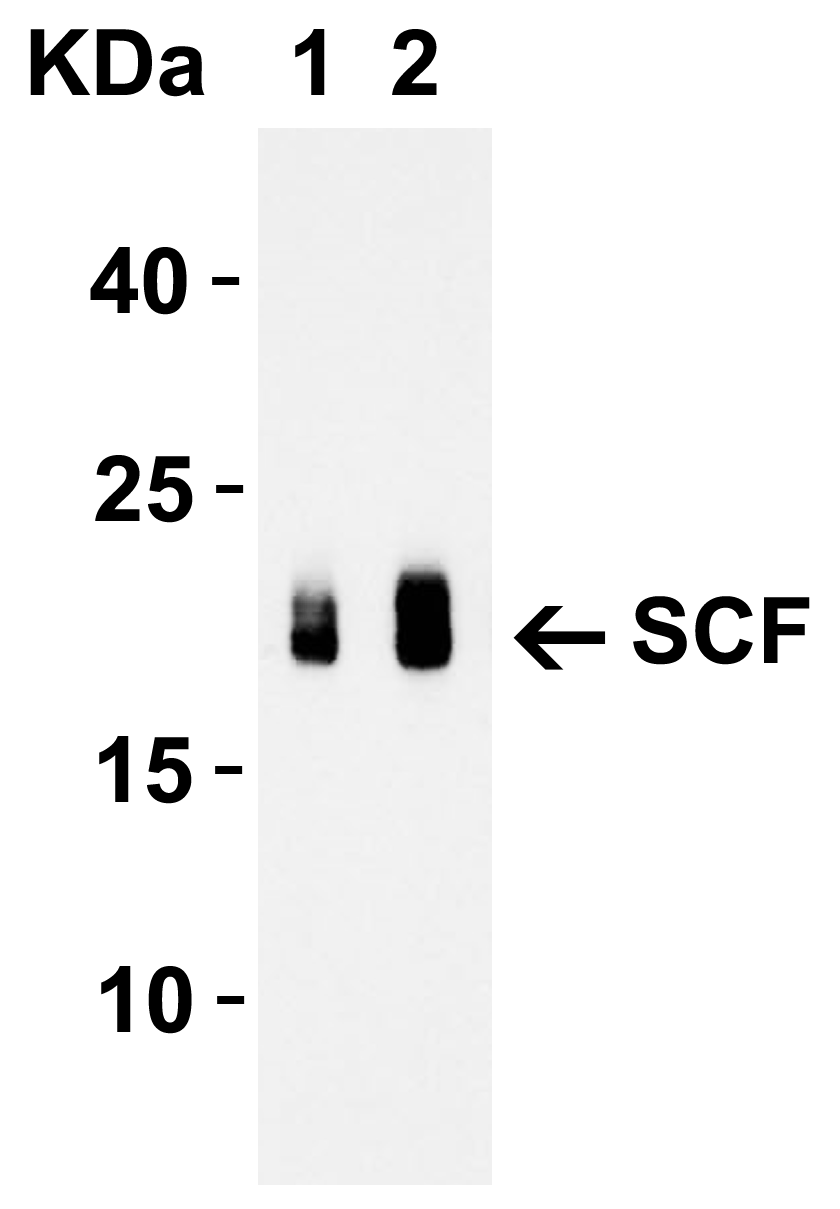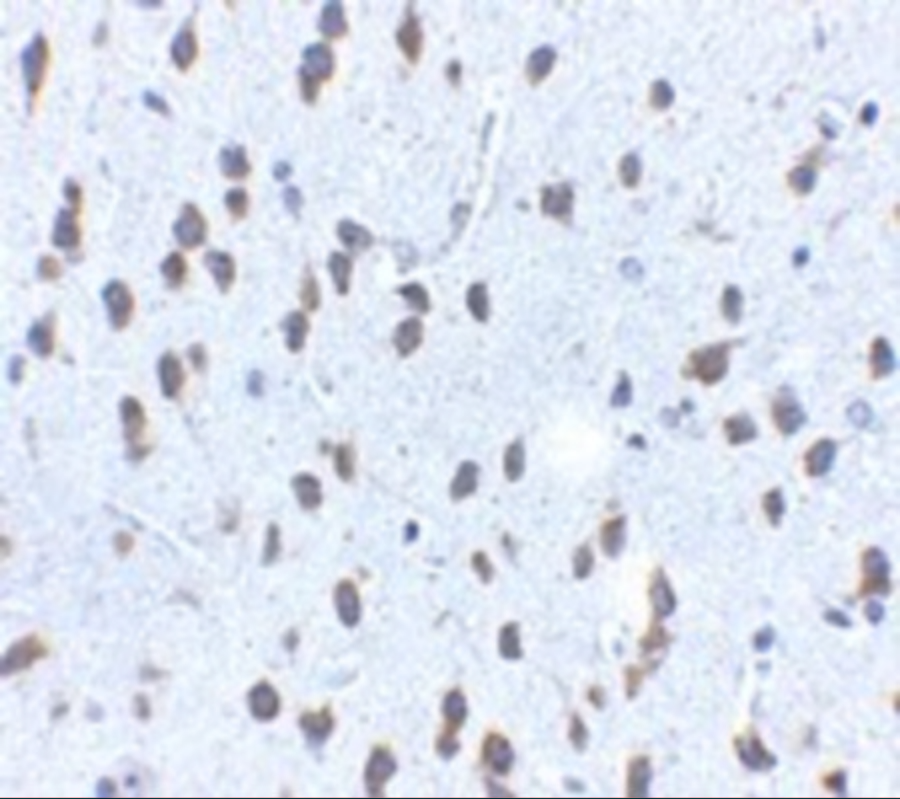SCF Antibody
| Code | Size | Price |
|---|
| PSI-5165-0.02mg | 0.02mg | £150.00 |
Quantity:
| PSI-5165-0.1mg | 0.1mg | £449.00 |
Quantity:
Prices exclude any Taxes / VAT
Overview
Host Type: Rabbit
Antibody Isotype: IgG
Antibody Clonality: Polyclonal
Regulatory Status: RUO
Applications:
- Enzyme-Linked Immunosorbent Assay (ELISA)
- Immunofluorescence (IF)
- Immunohistochemistry (IHC)
- Western Blot (WB)
Images
Documents
Further Information
Additional Names:
SCF Antibody: SF, MGF, SCF, FPH2, KL-1, Kitl, SHEP7, Kit ligand, Mast cell growth factor
Application Note:
WB: 1-2 μg/mL; IHC: 2.5 μg/mL; IF: 20 μg/mL.
Antibody validated: Western Blot in human, mouse and rat samples; Immunohistochemistry in mouse samples; Immunofluorescence in human samples. All other applications and species not yet tested.
Antibody validated: Western Blot in human, mouse and rat samples; Immunohistochemistry in mouse samples; Immunofluorescence in human samples. All other applications and species not yet tested.
Background:
SCF Antibody: Stem cell factor (SCF) is the ligand of the c-Kit oncogene and is expressed by various structural and inflammatory cells in the airways. Binding of SCF by the c-Kit receptor leads to homodimerization of the receptor and the activation of signalling pathways such as PI-3, PLC-gamma, Jak/STAT, and MAP kinase pathways. SCF expression leads to the induction of mast cell survival and the expression and release of histamine, pro-inflammatory cytokines and chemokines. The inhibition of the SCF/c-Kit pathway leads to a decrease in histamine levels, mast cell and eosinophil infiltration, IL-4 production and airway hyperresponsiveness, suggesting this pathway may be a useful therapeutic target in inflammatory diseases such as asthma. At least two isoforms of SCF are known to exist.
Background References:
- Reber et al. Euro. J. Pharmacology 2006; 533:327-40.
- Jensen et al. Inflamm. Allergy Drug Targets 2007; 6:57-62.
- Lukacs et al. J. Immunol. 1996; 156:3945-51.
Buffer:
SCF Antibody is supplied in PBS containing 0.02% sodium azide.
Concentration:
1 mg/mL
Conjugate:
Unconjugated
DISCLAIMER:
Optimal dilutions/concentrations should be determined by the end user. The information provided is a guideline for product use. This product is for research use only.
Homology:
Predicted species reactivity based on immunogen sequence: Bovine: (71%)
Immunogen:
Anti-SCF antibody (5165) was raised against a peptide corresponding to 18 amino acids near the center of human SCF.
The immunogen is located within amino acids 100-150 of SCF.
The immunogen is located within amino acids 100-150 of SCF.
ISOFORMS:
Human SCF has 3 isoforms, including isoform 1 (273aa, 30.9kD), isoform 2 (245aa, 27.9kD) and isoform 3 (238aa, 26.7kD). Mouse SCF has 2 isoforms, including isoform 1 (273aa, 30.6kD) and isoform 2 (245aa, 27.6kD). Rat SCF also has 2 isoforms, including isoform 1 (273aa, 30.7kD) and isoform 2 (245aa, 27.7kD). 5165 can detect human and possibly detect mouse and rat.
NCBI Gene ID #:
4254
NCBI Official Name:
KIT ligand
NCBI Official Symbol:
KITLG
NCBI Organism:
Homo sapiens
Physical State:
Liquid
PREDICTED MOLECULAR WEIGHT:
Predicted: 31kD
Observed: 36 kD (31kD + 4 N-linked Glycosylations)
Observed: 36 kD (31kD + 4 N-linked Glycosylations)
Protein Accession #:
P21583
Protein GI Number:
134289
Purification:
SCF Antibody is affinity chromatography purified via peptide column.
Research Area:
Stem Cell
Swissprot #:
P21583
User NOte:
Optimal dilutions for each application to be determined by the researcher.
VALIDATION:
Recombinant Protein Test (Figure 2): Anti-SCF antibodies (5165) detected human SCF recombinant protein at different concentrations.
Regulated expression validation (Figure 7 & 8): SCF expression detected by anti-SCF antibodies (5165) was up-regulated by angiotensin II (Ang II) treatment and was down-regulated by two inhibitors (Figure 7) or CNP treatment (Figure 8).
References
- Zhang et al. Up-regulation of the Ang II/AT1 receptor may compensate for the loss of gastric antrum ICC via the PI3k/Akt signaling pathway in STZ-induced diabetic mice. Mol Cell Endocrinol. 2016;423:77-86.PMID: 26773730
- Wu et al. Diabetes-induced loss of gastric ICC accompanied by up-regulation of natriuretic peptide signaling pathways in STZ-induced diabetic mice. Peptides. 2013;40:104-11. PMID: 23352981
Related Products
| Product Name | Product Code | Supplier | SCF Peptide | PSI-5165P | ProSci | Summary Details | |||||||||||||||||||||||||||||||||||||||||||||||||||||||||||||||||||||||||||||||||||||||||||||
|---|---|---|---|---|---|---|---|---|---|---|---|---|---|---|---|---|---|---|---|---|---|---|---|---|---|---|---|---|---|---|---|---|---|---|---|---|---|---|---|---|---|---|---|---|---|---|---|---|---|---|---|---|---|---|---|---|---|---|---|---|---|---|---|---|---|---|---|---|---|---|---|---|---|---|---|---|---|---|---|---|---|---|---|---|---|---|---|---|---|---|---|---|---|---|---|---|---|---|---|










